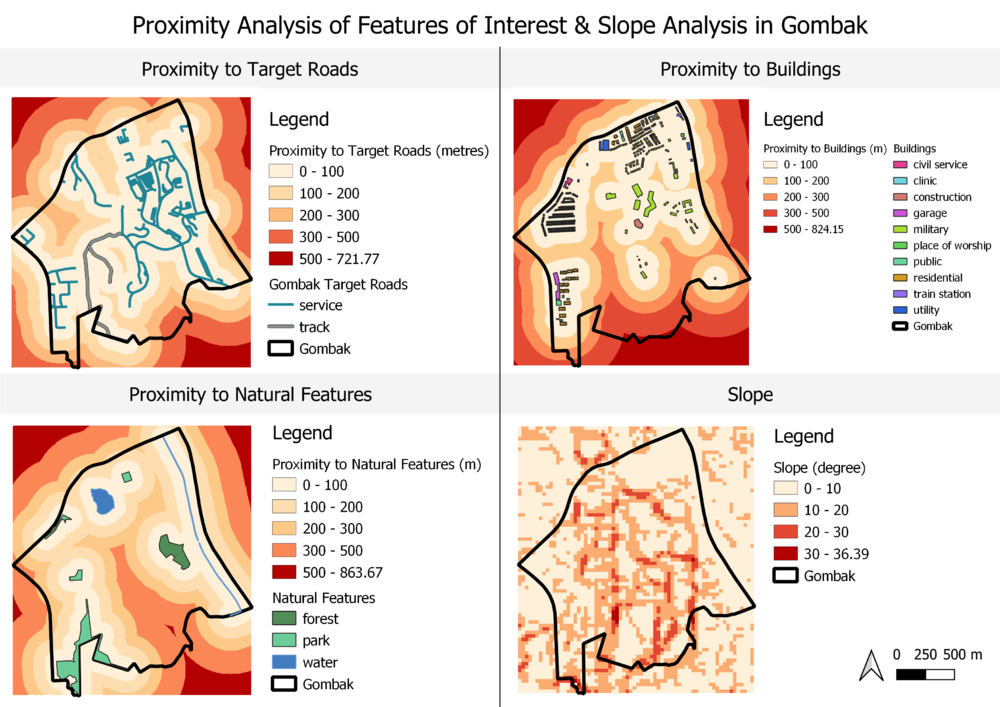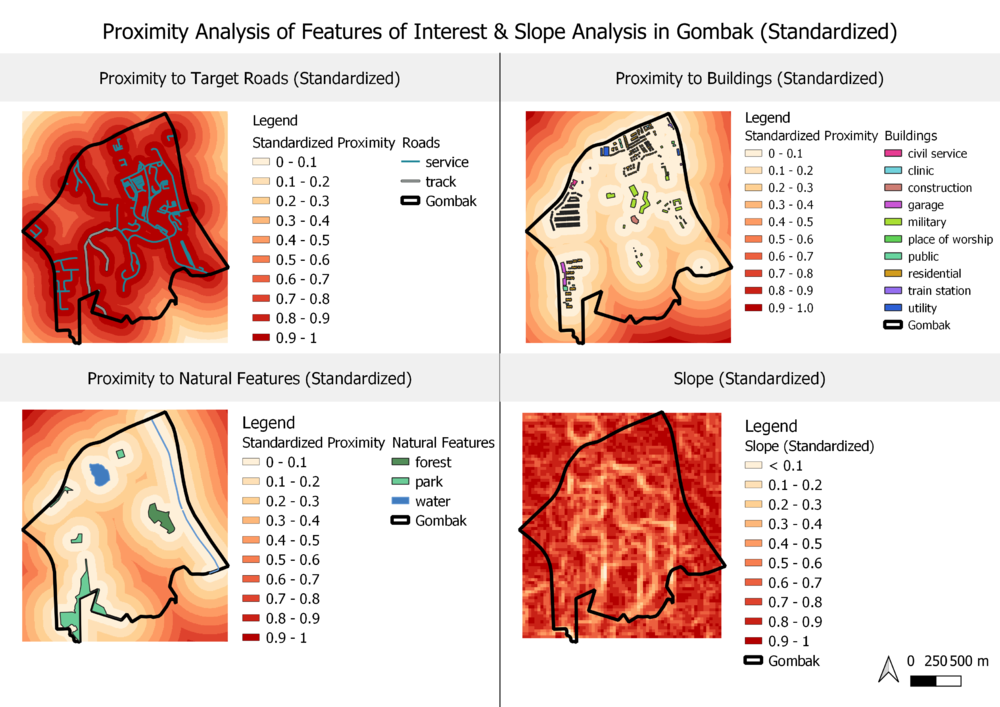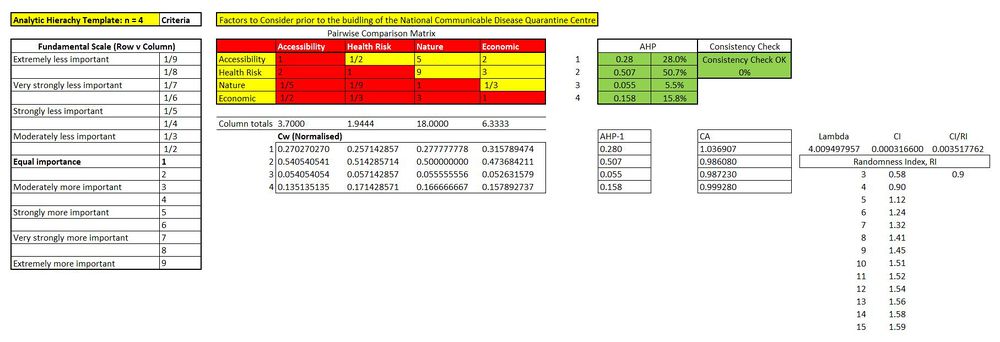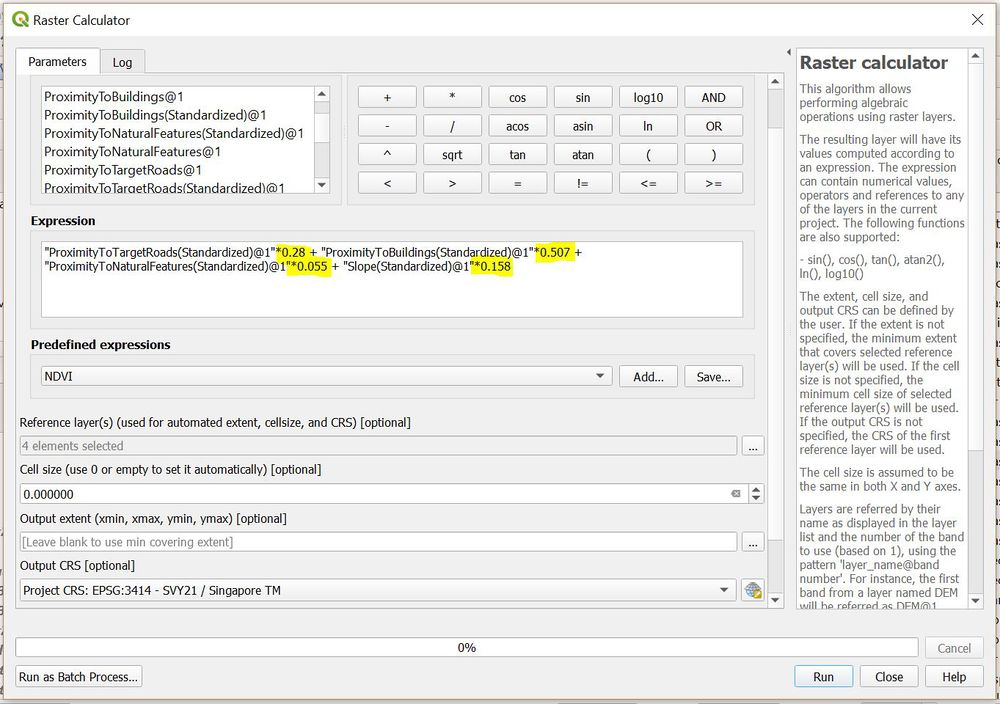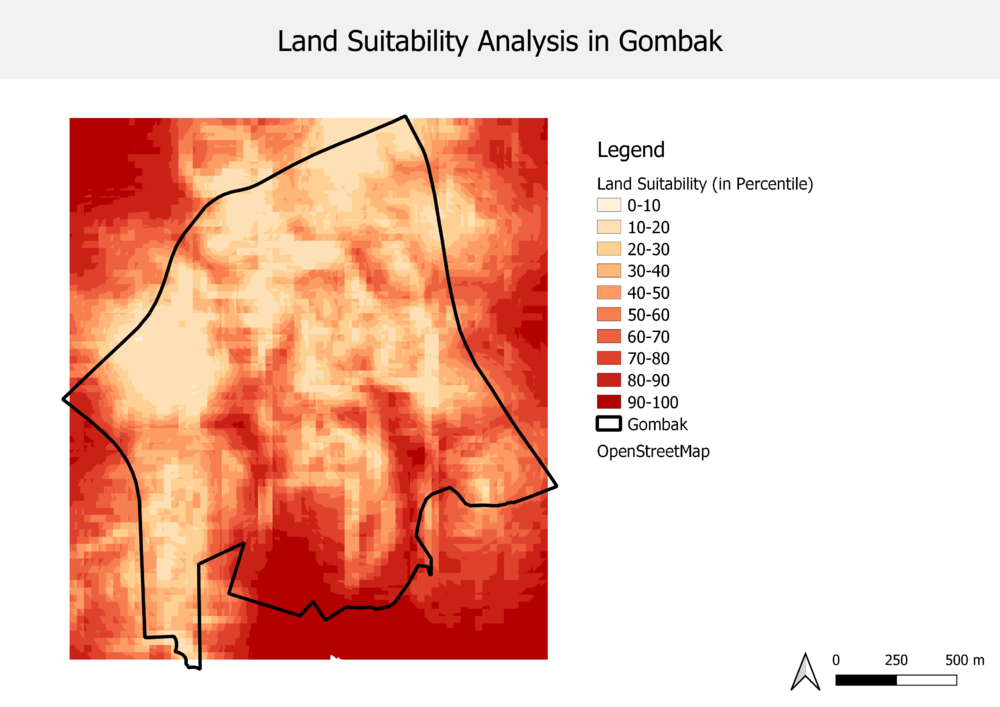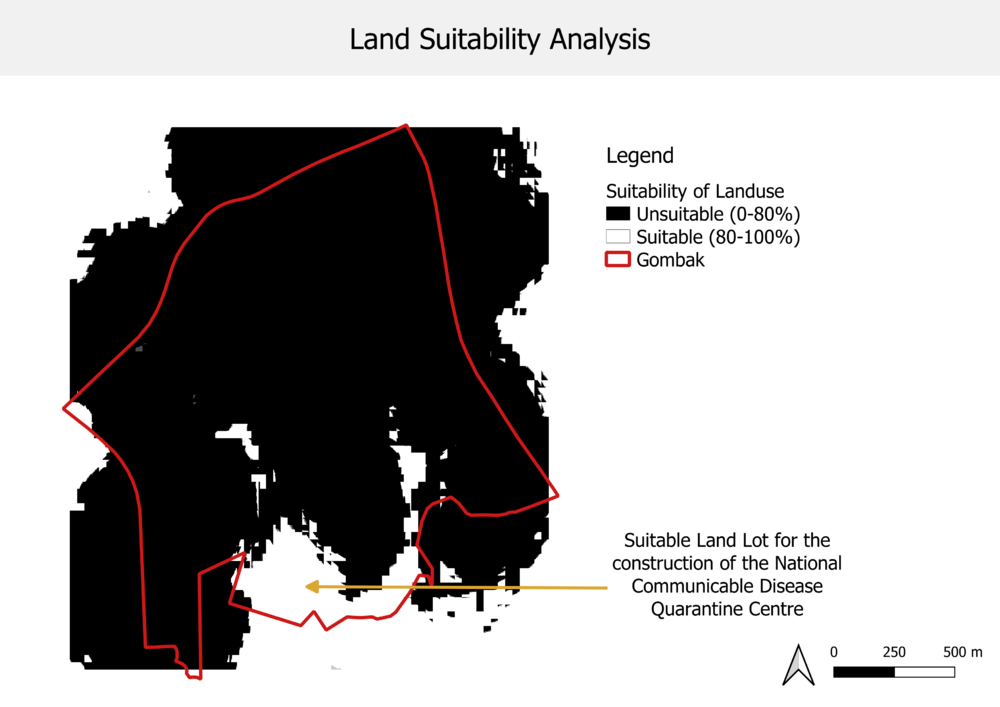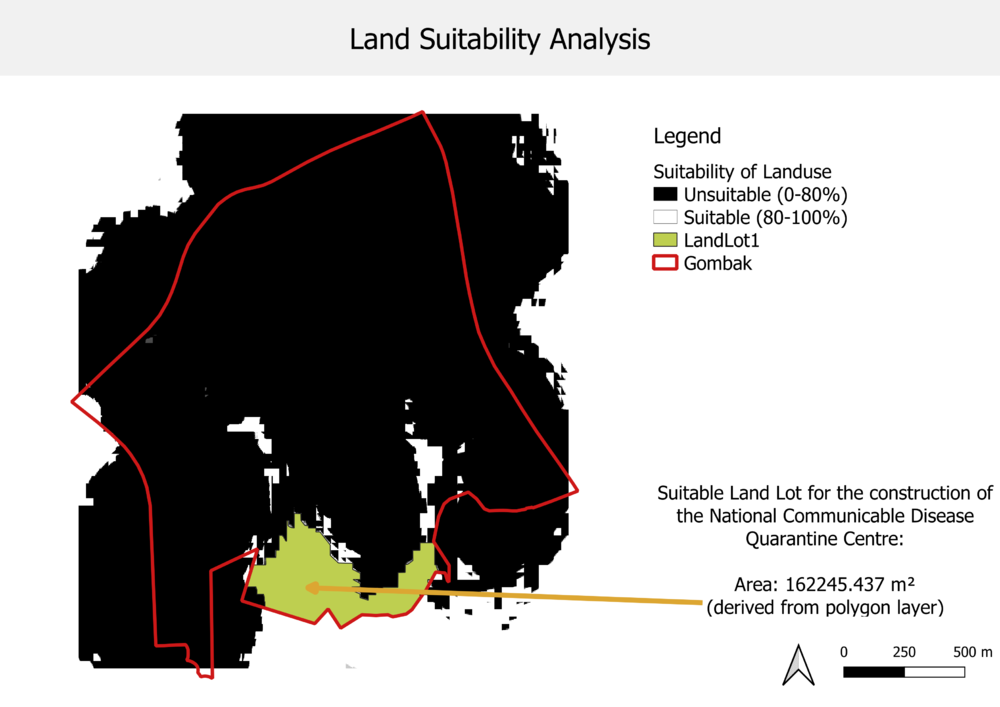SMT201 AY2019-20G2 Ex2 Mabelle Tham Shiqin
hi Mabelle hope u finish this soon :) jiayous
Contents
The Task : Building a National Communicable Disease Quarantine Centre
In this exercise, we are tasked to identify a location suitable for building a National Communicable Disease Quarantine Centre. The selected site must be located at Gombak planning subzone, with a contiguous area of at least 10,000m2 and it must meet the following decision factors:
1. Economic factor: The selected site should avoid steep slope. This is because construction at steep slope tends to involve a lot of cut-and-fill and will lend to relatively higher development cost.
2. Accessibility factor: The selected site should be close to existing local roads, namely: service roads and tracks. This is to ensure easy transportation of building materials during the construction stage.
3. Health risk factor: The selected site should be away from population i.e. housing areas and offices in order to avoid disease spreading to the nearby population.
4. Natural conservation factor: The selected site should be away from forested land, park and water.
Overview
A map layout with four views showing:
the study area and the target roads, the study area and buildings, the study area and the target natural features, the study area and digital elevation, and
Figure 1: Understanding our Study Area, Bukit Gombak
Accessibility Factor - Roads
As seen in the figure, the target roads are of different thickness to replicate reality where the tracks are wider and thus are represented bu thicker grey line vectors. A higher concentration of 199 service roads are observed at the north-east section of Gombak. Whereas there are only 2 tracks located towards the south-west portion of Gombak. The selected land lot should preferably be close and easily accessible to local roads, particularly service road and tracks to ensure smooth construction of the National Communicable Disease Quarantine Centre.
Health Risk Factor - Buildings
Data provided by OpenStreetMap included 7 types of buildings namely clinic, construction site, garage, place of worship, public space, residential area and train station. However 505/527 building 'types' were unknown. After cleaning the data by referring to data available on google, the buildings are then categorised by their type. From the map, we notice that residential buildings are the most common building type in Gombak. It should be noted that the selected site should be situated away from population i.e. housing areas and offices in order to avoid disease spreading to the nearby population.
Natural Conservation Factor - Natural Features
From Figure 1, forested land takes up about 35km2 in the eastern region of Gombak, parks are generally located towards the southwest region of Gombak and totals up to 88.2km2 and waterstream in the eastern region of Gombak takes up about 12.7km2. It should be noted that the selected site should be away from forested land, park and water.
Economic Factor - Digital Elevation
From the Elevation legend, we can see that the slope in Gombak varies from 0 to 36.39 degree. Using the ranking model: ranking scores, I classified the slope degree using the following criteria:
<=10 degree most favourable, 10-20 favourable, 20-30 unfavourable, and 30-36.39 as unfavourable. The selected site should avoid steep slope. This is because construction at steep slope tends to involve a lot of cut-and-fill and will lend to relatively higher development cost.
Proximity
A map layout with four views showing: the study area and proximity to target roads layer, the study area and proximity to buildings layer, the study area and proximity to target natural features layer, the study area and slope layer
Figure 2: Proximity Analysis on the Four Factors
A proximity analysis on the four factors is conducted to find out how where the most suitable land lot should be located, based on our criterias as mentioned above.
Based on the Ranking Model: Ranking Scores,
I derived binary data for the 4 features by using the following criteria and characterized them as such.
Accessibility Factor (To Target Roads, Buildings and Natural Features):
Sectioning the features by <= 100m, 100-200m, 200-300m, 300-500m and >500 from target roads consisting of service roads and tracks, buildings in Gombak Area mainly made up of residential buildings and military buildings and Natural Features such as Bukit Batok Town Park, Pheonix and Pavillion Park.
As seen from Figure 2, the lighter shades represent closer proximity to the features of interest and a gentler slope.
Proximity to Roads
Since accessibility is one of the determining factors, sites represented by the lighter shades located closer to existing service roads and tracks in the 0-100m or 100-200m ranges are preferred
Proximity to Buildings
As health risk is one of the determining factors, the selected site should be away from population i.e. housing areas and offices in order to avoid disease spreading to the nearby population. These areas are represented by the darker shades of red, preferably in the ranges 300-500m or >=500m.
Proximity to Natural Features
With natural conservation as one of the determining factors, the selected site should be located away from forested land, park and water. This means that areas with darker shades, preferably within the 300-500m and >=500m range are preferred.
Slope Analysis
From the slope legend, we can see that the slope in Gombak varies from 0 to 36.39 degree. Using the ranking model: ranking scores, I classified the slope degree using the following criteria:
<=10 degree most favourable, 10-20 favourable, 20-30 unfavourable, and 30-36.39 as unfavourable. The selected site should avoid steep slope. This is because construction at steep slope tends to involve a lot of cut-and-fill and will lend to relatively higher development cost.
Criterion Scores
To standardize the suitability of each determining factor in building the National Communicable Disease Quarantine Centre, I used the min-max method - one of the 3 criterion standards=ization techniques taught in class.
Figure 3: Min-Max Method, using Criterion Standardization Techniques
With the standardized results, a more reliable and consistent proximity analysis is conducted.
Figure 4: Standardized Proximity Analysis of Study Area, Bukit Gombak
Accessibility Score
Formula: 1 - (X meters) / 722.50 meters
The standardised score is calculated using 1 - (MinMax) as land lots closer to the roads are preferred and hence should have a higher accessibility score.
Health Risk Score
Formula: (X meters) / 824.98 meters
The standardized proximity to building relates directly to the criterion score for health risk factor. With a lower proximity to buildings, the distance to the building from the Quarantine Centre will be further away which is preferred when building the National Communicable Disease Quarantine Centre as that will result in a lower possibility of disease spreading to the nearby population.
Natural Conservation Score
Formula: (X meters) / 863.67 meters
The standardized proximity to Natural Features relates directly to the criterion score for Natural Conservation factor. With a lower proximity to the natural features, the distance to the neatural features from the Quarantine Centre will be further away which is preferred when building the National Communicable Disease Quarantine Centre as that will result in a higher possibility of conserving the natural features in Gombak, lowering the chances of polluting it.
Economic Score
Formula: 1 - (X deg) / 36.43 deg
The standardised score is calculated using 1 - (MinMax) as land lots with gentler slopes are preferred and hence should have a higher economic score whereas land lots with steeper slopes are less favourable and hence should have a lower economic score as building in areas with a higher slope would result in higher economic costs.
Analytical Hierarchical Process Input Matrix
Figure 5: Using Analytical Hierarchical Process (AHP)
While SAGA (a function in QGIS) provides Analytical Hierarchical Process function, the function does not provide a detailed report. In view of this, we used an Excel-based AHP library such as the AHP Template provided by SCB Associates (AHP Template from SCBUK (XLS)[1]).
The Analytical Hierarchical Process, is a method for decision making in situations where multiple objectives are present. It uses a pair wise comparison matrix to calculate the relative value and costs of factors/requirements.
By using AHP, the requirements engineer can also confirm the consistency of the
result. AHP can prevent subjective judgment errors and increase the likelihood that the results are reliable.
As seen from figure 5, the Health Risk factor has the highest weightage of 0.507 followed by Accessibilty factor of 0.28 weightage, Economic factor of 0.158 and Nature Factor of 0.055 weightage. This is so as when building the National Communicable Disease Quarantine Centre, the factors should be prioritized by health risks, accessibility, economic factors and nature accordingly. This is because as a quarantine centre, it is important that the centre is located far from buildings. Especially for a very densely populated country like Singapore where there is high human traffic.
Accessibility is the 2nd most impotant factor with a weight of 0.28 as the accessibility for construction will only affect a small population - people associated with the construction of the quarantine centre, and for a relatively shorter period (during construction) which may take about 2 to 5 years.
Economic factor comes in as the 3rd most important factor with a weight of 0.158 as the costs of construction will eventually be covered by years of operation and has a lesser impact on the population.
The natural conservation factor comes in last with a weight of 0.055 as Gombak has very sparse nature (1 forest, 4 parks and a stream of water). It will be pretty easy to avoid building the quarantine centre near these nature and hence natural conservation is not a large issue.
With a consistency index/consistency ratio of 0.000316600%, this indicates that there is almost 0% inconsistency generated by the pairwise comparison matrix.
Raster Calculator to Compile Factors based on AHP
Figure 6: Compiling Standardized Factors
The land suitability analysis is done by multiplying the factors by their weights as seen in figure 6.
Suitability
Figure 7: Filtering possible suitable land lots by Percentile
To better visualize the suitability analysis, I used the Band Rendering function under Symbology in QGIS, and classified the suitability of land lots by percentiles using 10 classes. This was done using 'discrete' interpolation and 'Quantile' Mode.
As seen from Figure 7, there is higher land suitability in the southern parts of Gombak with suitability of 80-100% as compared to the northern parts of Gombak.
Figure 8: Reclassify (Land lots) by Table
For the purpose of this study, I decided to classify 0-80% as unsuitable landuse and 80-100% as land suitable for building. But reclassifying the suitability analysis, a large land area in the south of Gombak as seen in figure 8 (white area delineated by the red Gombak Subzone polygon) qualifies as land suitable for construction as it classifies under 80-100% suitability.
While there are a few sparse white spots in the central and west part of Gombak, these white 'suitable' areas are not as suitable as the southern white area as they are smaller in area and do not make up 10,000m2 which is one of the determining criterias for the construction of the quarantine centre.
Figure 9: A Map Layout with the Suitability Land Lot(s)
The digitized green area in south-most part of Gombak has an area of more than 162245.437m2 which surpasses the area required (10,000m2). In addition, as the land area is very large, there is a large potential for future growth and expansion
Conclusion
Upon evaluation, I realised that my proximity analysis could have been more accurate if I used the Mask Raster Layer instead of the Extent layer, as the extent layer includes areas out of the delineated subzone 'Gombak' area. This makes the analysis less reliable. However, it is a consistent error made and hence the analysis is not as unreliable.

